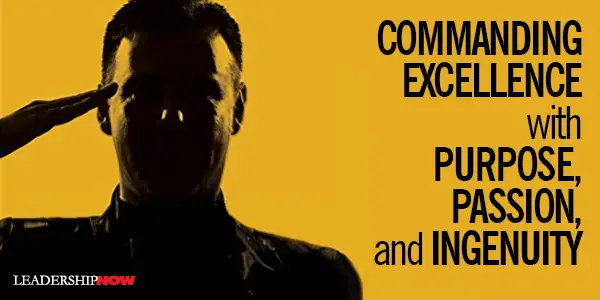 |
 |
12.13.17

Commanding Excellence with Purpose, Passion, and Ingenuity
G Commanding Excellence describes how these two leaders led their respective organizations to incredible success. Fred Dibella says the account is “about everyone signing up and them pulling their weight, so the whole becomes greater than the sum of its parts.” What made these organizations stand out was the simplicity of their leadership driven by an absolute clarity of purpose, empowered obsession, and unleashed creativity. Morton illustrates how each of these was manifested in these organizations. Absolute Clarity of Purpose The first all-important question to ask is, “What are we trying to achieve?” After that, all distractions were eliminated or deliberately de-emphasized, and a playbook was developed to codify the mission. “Success would not come from devising an ingenious plan for each battle but from hard work in executing the six simple plays that relied on disciplined execution.” Having this kind of clarity simplifies managing. In most cases, decisions did not require higher-level endorsement; the purpose served as a guide. What made it work is that everything was structured around the mission. There was accountability at every level as lines of authority were drawn, “first and foremost, for maximal effectiveness in combat, and, second, for effectiveness in training and preparation. The mission-focused structure was decentralized from the standpoint that each commander was given great freedom to execute, but they were also expected to cooperate with the decentralized companies and share everything with other teams. Morton credits the structure working because it was developed and built around strengths. “Dibella did not believe that all men do all things well, and he felt it was foolhardy to ask them to do so.” Brown did the same thing at Stryker with his 20-percent annual growth goal and the mantra: Invent it, make it, sell it. “Everyone in the organization knew the goal, acknowledged how important it was to the organization, and understood how they could contribute to the achievement.” Empowered Obsession Clarity isn’t enough. “Clarity was the foundation, but the walls and roof were built around shared obsession.” Brown and Dibella drove this obsession. They were both “seriously afflicted by an absolute, monomaniacal obsession, and spreading that obsession throughout the organization—every person, process, and method of measuring anything meaningful—was central to their leadership.” Everyone felt a deep personal ownership of the goal and knew that their actions were absolutely essential to attaining it. What you did mattered and it was rewarded. Stability in the teams was important. 4-68 leadership determined that “gains from stability—mainly unit-to-unit and soldier-to-soldier relationships—would trump any gains that might come from tailoring the organization for a particular mission.” Morton notes that “Greatness may require all-star talent, but only when a group of talented individuals is stabilized and able to bond into a cohesive team over time so they deliver their top performance.” Unleashed Creativity Clarity of purpose provided the why. Obsession delivered the high-performance. And unleashed creativity made it possible. Ingenuity was essential. “The thirst for better ways of doing things was deeply interwoven into the organizational mindset.”
Rank plays no part here. Ideas are elevated on their merit. Dibella “embraced every new idea that moved us closer to the goal.” In each organization, their purpose required radically different methods and new thinking. “Both leaders exhibited a considerable understanding for mistakes of the mind but little for mistakes of the heart.” 
Posted by Michael McKinney at 07:54 AM
|
BUILD YOUR KNOWLEDGE
 

How to Do Your Start-Up Right STRAIGHT TALK FOR START-UPS 
Grow Your Leadership Skills NEW AND UPCOMING LEADERSHIP BOOKS 
Leadership Minute BITE-SIZE CONCEPTS YOU CAN CHEW ON 
Classic Leadership Books BOOKS TO READ BEFORE YOU LEAD |